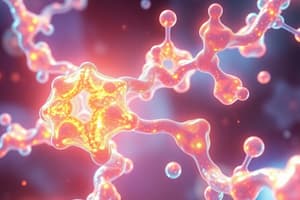Podcast
Questions and Answers
What aspect distinguishes prokaryotes from eukaryotes?
What aspect distinguishes prokaryotes from eukaryotes?
- Reproductive methods
- Presence of a nucleus (correct)
- Cell size
- Cell wall composition
Which type of bond involves the transfer of electrons from one atom to another?
Which type of bond involves the transfer of electrons from one atom to another?
- Ionic bond (correct)
- Covalent bond
- Hydrogen bond
- Van der Waals interaction
Which cellular organelle is involved in energy production?
Which cellular organelle is involved in energy production?
- Golgi apparatus
- Mitochondrion (correct)
- Ribosome
- Nucleus
Which type of microscopy provides the highest resolution?
Which type of microscopy provides the highest resolution?
What is the primary function of chloroplasts in plant cells?
What is the primary function of chloroplasts in plant cells?
What characterizes lipophobic substances?
What characterizes lipophobic substances?
What is the role of valence electrons in chemical reactions?
What is the role of valence electrons in chemical reactions?
Which macromolecule is primarily responsible for catalyzing biochemical reactions?
Which macromolecule is primarily responsible for catalyzing biochemical reactions?
What are the ends of a protein called, which dictate the direction of translation?
What are the ends of a protein called, which dictate the direction of translation?
Where can you find DNA in eukaryotic cells?
Where can you find DNA in eukaryotic cells?
Which type of macromolecule is made up of nucleotides?
Which type of macromolecule is made up of nucleotides?
What distinguishes phospholipids from other lipids?
What distinguishes phospholipids from other lipids?
What individual monomers are found in triglycerides?
What individual monomers are found in triglycerides?
In which cellular location would you find RNA in prokaryotic cells?
In which cellular location would you find RNA in prokaryotic cells?
Which of the following is a characteristic of all lipids?
Which of the following is a characteristic of all lipids?
What is an example of a lipid you might find in your body?
What is an example of a lipid you might find in your body?
What is the basic unit of life?
What is the basic unit of life?
Which of the following sequences correctly represents the Central Dogma of molecular biology?
Which of the following sequences correctly represents the Central Dogma of molecular biology?
Which of the following structures do eukaryotes have that prokaryotes do not?
Which of the following structures do eukaryotes have that prokaryotes do not?
Where is bacterial DNA located within a bacterial cell?
Where is bacterial DNA located within a bacterial cell?
What type of macromolecule is primarily formed from monosaccharides?
What type of macromolecule is primarily formed from monosaccharides?
What must occur before a cell can divide?
What must occur before a cell can divide?
Which structure is expected to aid in the storage of glucose in animals?
Which structure is expected to aid in the storage of glucose in animals?
Which of the following statements is true about prokaryotes and eukaryotes?
Which of the following statements is true about prokaryotes and eukaryotes?
What is the molecular formula characteristic of carbohydrates?
What is the molecular formula characteristic of carbohydrates?
Which of the following is NOT a shared component between prokaryotes and eukaryotes?
Which of the following is NOT a shared component between prokaryotes and eukaryotes?
What is the function of proteins in cellular processes?
What is the function of proteins in cellular processes?
What individual units combine to form proteins?
What individual units combine to form proteins?
Where would you typically find cellulose, a carbohydrate?
Where would you typically find cellulose, a carbohydrate?
Which of the following statements best describes the composition of amino acids?
Which of the following statements best describes the composition of amino acids?
In which cellular location would you expect proteins to be significantly involved?
In which cellular location would you expect proteins to be significantly involved?
Which macromolecule is formed through the process of polymerization, involving the loss of water from -NH2 and -COOH groups?
Which macromolecule is formed through the process of polymerization, involving the loss of water from -NH2 and -COOH groups?
How many total electrons does magnesium (Mg) have?
How many total electrons does magnesium (Mg) have?
How many valence electrons are present in magnesium's outer shell?
How many valence electrons are present in magnesium's outer shell?
How many additional electrons does magnesium need to fill its outer shell?
How many additional electrons does magnesium need to fill its outer shell?
What distinguishes isotopes of an element?
What distinguishes isotopes of an element?
What type of bond involves the sharing of electrons between atoms?
What type of bond involves the sharing of electrons between atoms?
Which type of bond is characterized by the transfer of electrons?
Which type of bond is characterized by the transfer of electrons?
What best defines hydrogen bonds?
What best defines hydrogen bonds?
Which of the following is true about polar covalent bonds?
Which of the following is true about polar covalent bonds?
Study Notes
Van Der Waals Forces
- Weak interactions
- Can be powerful when many work together
LO #10: Macromolecules
Carbohydrates (Sugar)
- Example: Glucose, Glycogen (starch and cellulose in plants)
- General molecular formula: CN(H2O)N
- Individual monomers = Monosaccharides
- Found in cell walls (prokaryotes, plants, fungi). Created in chloroplasts. Catabolized in mitochondria. Starch in plant vacuoles. Glycogen in muscles. Modifies proteins and lipids
Proteins
- Example: Insulin, Growth Hormone, Actin, Myosin
- Contain -CH + Amino group (-NH2) + Carboxylic acid group (-COOH) + R group (unique for each amino acid)
- Individual monomers = Amino Acids
- Found in receptors, transport proteins (in membranes), motor proteins (in cytoplasm), crucial structures in many cell organelles
- Proteins are translated directionally - N-terminal to C-terminal
Nucleic Acids
- Example: DNA and RNA
- Consists of a sugar + phosphate backbone, and nitrogenous base
- Individual monomers = Nucleotides
- Found in the cytoplasm (within the nucleoid region) in prokaryotes. DNA in the nucleus of eukaryotes. RNA in the nucleus or cytoplasm of eukaryotes.
Lipids
- Example: Phospholipids, Triglyceride, and Steroid Hormones
- Have hydrocarbon portions that are hydrophobic
- Phospholipids and triglycerides have fatty acid tails, but steroids do not
- Found in cell membranes and membrane bound organelles
LO #1: Unity and Diversity of Life
- The basic unit of life is the cell
- Cells are bound by membranes and contain genetic material
- Cells can self-replicate
LO #1: Central Dogma
- DNA → mRNA → Protein
- This pathway is needed before cell division and required to perform cellular functions
LO #2: Prokaryotes and Eukaryotes
- Prokaryotes: Simpler cells without a nucleus and membrane bound organelles. Examples include bacteria and archaea
- Eukaryotes: More complex cells with a nucleus and membrane bound organelles. Examples include plants, animals, and protists
- Prokaryotic DNA is found within the cytoplasm
LO #3 & 4: Cellular Organelles
- Cell membranes: Regulates passage of molecules into and out of cells
- Cytoplasm: Gel-like substance that fills the cell
- Ribosomes: Responsible for protein synthesis
- Nucleus: Houses the cell's DNA
- Endoplasmic Reticulum (ER): Network of membranes that synthesize lipids and proteins, involved in detoxification
- Golgi Apparatus: Modifies, sorts, and packages proteins from the ER
- Lysosomes: Breakdown and recycle cellular components, often containing enzymes
- Mitochondria: "Powerhouse" of the cell, responsible for cellular respiration, generate ATP
- Vacuoles: Storage compartments for water, waste, and essential nutrients
- Chloroplasts: Found in plant cells, responsible for photosynthesis
- Cell Wall: Provides structural support and protection, found in prokaryotes, plants, and fungi
**LO #7: Valence Electrons and Chemical Reactivity **
- The periodic table can determine the number of valence electrons in an atom
- Valence electrons determine the chemical reactivity of atoms
LO #8: Chemical Bonding
- Covalent bonds: Formed when atoms share electrons.
- Non-polar covalent bond: Equal sharing of electrons
- Polar covalent bond: Unequal sharing of electrons
- Ionic bonds: Formed when atoms transfer electrons.
- Hydrogen bonds: Weak bonds that form between different molecules, often involving hydrogen
LO #8: Isotopes
- Isotopes have the same number of protons but different numbers of neutrons
- Radioisotopes are powerful scientific tools
- Radioactive isotopes like C14 can be used for carbon dating, while others are used in cancer detection
LO #9: Hydrophilic, Hydrophobic, Polar, Non-polar, Lipophilic, Lipophobic, Amphipathic
- Hydrophilic: Water loving (polar)
- Hydrophobic: Water fearing (non-polar)
- Polar: Molecules with uneven distribution of charges
- Non-polar: Molecules with even distribution of charges
- Lipophilic: Fat loving (non-polar)
- Lipophobic: Fat fearing (polar)
- Amphipathic: Possessing both hydrophilic and hydrophobic regions (example: phospholipids)
Studying That Suits You
Use AI to generate personalized quizzes and flashcards to suit your learning preferences.
Related Documents
Description
Explore the fascinating world of macromolecules in this quiz. You'll cover key concepts related to carbohydrates, proteins, and nucleic acids, including their structures and functions in biological systems. Challenge your knowledge and understanding of these essential biomolecules.




